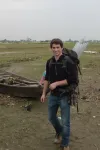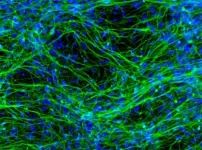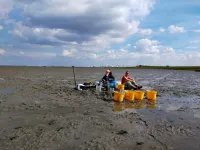(Press-News.org) Living in neighborhoods with high levels of violence can affect children’s development by changing the way that a part of the brain detects and responds to potential threats, potentially leading to poorer mental health and other negative outcomes, according to research published by the American Psychological Association.
However, nurturing parents can help protect kids against these detrimental effects, according to the study, published in the journal Developmental Psychology.
“Decades of research has shown that growing up in neighborhoods with concentrated disadvantage can predict negative academic, behavioral and mental health outcomes in children and teens. And recent research is beginning to show that one way it does that is by impacting the developing brain,” said study co-author Luke W. Hyde, PhD, of the University of Michigan. “However, less is known about how neighborhood disadvantage ‘gets under the skin’ to impact brain development.”
Hyde and his colleagues hypothesized that one way might be through the amygdala, the hub of the brain’s stress response system that’s involved in socioemotional functioning, threat processing and fear learning. The amygdala is sensitive to facial expressions, and previous research has found that children who have been abused or neglected by family members, for example, show increased reactivity in the amygdala when looking at faces with negative, fearful or neutral expressions.
To study whether exposure to neighborhood violence might also affect children’s amygdala reactivity, the researchers analyzed data from 708 children and teens ages 7 to 19, recruited from 354 families enrolled in the Michigan Twins Neurogenetic Study. Most were from neighborhoods with above-average levels of poverty and disadvantage, as measured by the U.S. Census Bureau. Fifty-four percent of the participants were boys, 78.5% were white, 13% were Black and 8% were other races and ethnicities. The participants lived in a mix of rural, suburban and urban areas in and around Lansing, Michigan.
Teens completed a set of surveys that asked about their exposure to community violence, their relationship with their parents and their parents’ parenting style. Participants also had their brains scanned by functional MRI while they looked at faces that were angry, fearful, happy or neutral.
Overall, the researchers found that participants who lived in more disadvantaged neighborhoods reported more exposure to community violence. And participants who reported more exposure to community violence showed higher levels of amygdala reactivity to fearful and angry faces. The results held true even when controlling for an individual family’s income, parental education and other forms of violence exposure in the home, such as harsh parenting and intimate partner violence.
“This makes sense as it’s adaptive for adolescents to be more in tune to threats when living in a more dangerous neighborhood,” said Hyde.
However, he and his colleagues also found that nurturing parents seemed to be able to break the link between community violence and amygdala reactivity in two ways.
“Despite living in a disadvantaged neighborhood, children with more nurturing and involved parents were not as likely to be exposed to community violence, and for those who were exposed, having a more nurturing parent diminished the impact of violence exposure on the brain,” said Gabriela L. Suarez, a graduate student in developmental psychology at the University of Michigan and co-author of the study. “These findings really highlight how nurturing and involved parents are helping to support their children’s success, even in potentially harsh environments, and offer clues as to why some youth are resilient even when facing adversity.”
Overall, the researchers said, the study highlights the need for structural solutions to protect children from the negative impact of exposure to community violence. It also points to the ways in which strong, positive parents can promote resilience among children and teens exposed to adversity.
“Parents may be an important buffer against these broader structural inequalities, and thus working with parents may be one way to help protect children -- while we also work on policies to reduce the concentration of disadvantage in neighborhoods and the risk for exposure to violence in the community,” said co-author Alex Burt, PhD, of Michigan State University.
ARTICLE: “Exposure to Community Violence as a Mechanism Linking Neighborhood Disadvantage to Amygdala Reactivity and the Protective Role of Parental Nurturance,” by Gabriela L. Suarez and Luke W. Hyde, PhD, University of Michigan; S. Alexandra Burt, PhD, and Kelly L. Klump, PhD, Michigan State University; and Arianna M. Gard, PhD, University of Maryland College Park. Developmental Psychology, published online Feb. 22, 2024.
CONTACT: Hyde can be reached at lukehyde@umich.edu or through the University of Michigan press office at jwadley@umich.edu.
The American Psychological Association, in Washington, D.C., is the largest scientific and professional organization representing psychology in the United States. APA’s membership includes over 157,000 researchers, educators, clinicians, consultants and students. Through its divisions in 54 subfields of psychology and affiliations with 60 state, territorial and Canadian provincial associations, APA works to advance the creation, communication and application of psychological knowledge to benefit society and improve people’s lives.
END
Living in violent neighborhoods affects children's brain development
Nurturing parents can buffer against harmful effects, study finds
2024-02-22
ELSE PRESS RELEASES FROM THIS DATE:
World’s first real-time wearable human emotion recognition technology developed!
2024-02-22
A groundbreaking technology that can recognize human emotions in real time has been developed by Professor Jiyun Kim and his research team in the Department of Material Science and Engineering at UNIST. This innovative technology is poised to revolutionize various industries, including next-generation wearable systems that provide services based on emotions.
Understanding and accurately extracting emotional information has long been a challenge due to the abstract and ambiguous nature of human affects such as emotions, ...
MD Anderson acquires inducible switch technologies for cell therapy
2024-02-22
HOUSTON ― The University of Texas MD Anderson Cancer Center today announced it has acquired certain assets from Bellicum Pharmaceuticals, Inc. related to the CaspaCIDe® switch platform and the GoCAR® platform. The transaction also includes clinical-grade stocks of rimiducid, an agent used to trigger the switches.
As a result of this acquisition, MD Anderson may incorporate these platforms into its own cell therapy programs. The institution also intends to make the technology ...
UTSA doctoral student studies solutions to prevent contaminated water sources
2024-02-22
From Bangladesh to India to Texas, Tom Varner is leveraging his research to improve sources for drinking water around the world.
Varner, a UTSA doctoral student in environmental science and engineering, explored the mobility of arsenic from the sediments surrounding the Meghna River in Bangladesh as part of a National Science Foundation-funded project.
The river flows through central Bangladesh, where elevated concentrations of arsenic in the groundwater threaten the welfare of millions of people. Long-term exposure to arsenic, which is toxic when ingested, can lead ...
Treating newly-diagnosed Crohn’s patients with advanced therapy leads to dramatic improvements in outcomes
2024-02-22
A large-scale clinical trial of treatment strategies for Crohn’s disease has shown that offering early advanced therapy to all patients straight after diagnosis can drastically improve outcomes, including by reducing the number of people requiring urgent abdominal surgery for treatment of their disease by ten-fold.
The PROFILE trial, led by researchers at the University of Cambridge, involved 386 patients with newly-diagnosed active Crohn’s disease. Recruiting from 40 hospitals across the UK, and supported by the National Institute for Health and Care Research (NIHR) Clinical Research Network, it sought to test whether a biomarker – a genetic signature ...
Uncovering anxiety: Scientists identify causative pathway and potential cures
2024-02-22
Anxiety-related disorders can have a profound impact on the mental health and quality of life of affected individuals. Understanding the neural circuits and molecular mechanisms that trigger anxiety can aid in the development of effective targeted pharmacological treatments. Delta opioid receptors (DOP), which localize in the regions of the brain associated with emotional regulation, play a key role in the development of anxiety. Several studies have demonstrated the therapeutic effects of DOP agonists (synthetic compounds which selectively bind to DOPs and mimic the effect of ...
Stronger storms free more nutrients from mud flats
2024-02-22
If storms become stronger in the future due to climate change, more nitrogen may be released from the bottom of coastal seas. This is shown by research of marine biogeochemist Dunia Rios-Yunes at NIOZ in Yerseke. Rios-Yunes will defend her PhD-thesis today at the University of Utrecht. “The dynamics of nutrients in deltas and estuaries have been a bit of a blind spot for marine science, so far”, she says.
Inflatable couch
For her experiments, Rios-Yunes spent many hours on an inflatable couch on ...
New study is first step in predicting carbon emissions in agriculture
2024-02-22
MINNEAPOLIS / ST. PAUL (02/19/2024)—For the first time, researchers at the University of Minnesota Twin Cities (UMN) and the University of Illinois Urbana-Champaign (UIUC) have demonstrated that it is possible to provide accurate, high-resolution predictions of carbon cycles in agroecosystems, which could help mitigate the impacts of climate change.
The study by scholars from the UMN-led National Artificial Intelligence Institute for Climate-Land Interactions, Mitigation, Adaptation, Tradeoffs and Economy (AI-CLIMATE) and UIUC-led Agroecosystem Sustainability ...
Air pollution hides increases in rainfall
2024-02-22
We know that greenhouse gas emissions like carbon dioxide should increase rainfall. The emissions heat the atmosphere, causing a one-two punch: warmer oceans make it easier for water to evaporate, and warmer air can hold more water vapor, meaning more moisture is available to fall as rain. But for much of the 20th century, that increase in precipitation didn’t clearly show up in the data.
A new study led by researchers at the Department of Energy’s Lawrence Berkeley National Laboratory (Berkeley ...
Damage to cell membranes causes cell aging
2024-02-22
Our cells are surrounded by a fragile membrane that’s only 5 nanometers thick, 1/20 of a soap bubble. Cells are easily damaged by physiological activities, including muscle contraction and tissue injury. To cope with such damage, cells are equipped with mechanisms that can repair membrane damage to a certain degree.
Mechanical damage to the cell membrane was previously believed to trigger two simple cellular outcomes: recovery or death. In this study, however, the researchers uncovered a third outcome – cellular senescence.
“When I started this project, I simply aimed to understand ...
Mice surprise: Australian researchers discover new native species
2024-02-22
Australia can lay claim to two new species of native rodent thanks to a study from The Australian National University (ANU).
The aptly named delicate mouse was previously thought to be a single species spanning a massive stretch of the country from the Pilbara in Western Australia, across parts of the Northern Territory and through Queensland down to the New South Wales border.
But researchers at ANU and CSIRO thought there might be more to the story.
Lead author Dr Emily Roycroft, from ANU, said we now know there ...
LAST 30 PRESS RELEASES:
A new, cleaner way to make this common fertilizer
Fire-safe all-solid-state batteries move closer to commercialization
Disinfecting drinking water produces potentially toxic byproducts — new AI model is helping to identify them
Unplanned cesarean deliveries linked to higher risk of acute psychological stress after childbirth
Healthy aging 2026: fresh pork in plant-forward diets supported strength and brain-health biomarkers in older adults
Scientists identify pre-cancerous states in seemingly normal aging tissues
Itaconate modifications: mechanisms and applications
Potential tumor-suppressing gene identified in pancreatic cancer
Winners of the 2026 Hill Prizes announced
Autonomous AI agents developed to detect early signs of cognitive decline
Study finds ocean impacts nearly double economic cost of climate change
Increased deciduous tree dominance reduces wildfire carbon losses in boreal forests
Researchers discover how a respiratory bacterium obtains essential lipids from the human body and targets fat-rich tissues
Locust swarms destroy crops. Scientists found a way to stop that
More resources and collaboration needed to support prevention and treatment of obesity
Two types of underconfidence linked to anxiety and gender
Insects are victims too: Global study shows impacts of invasive alien species on populations
Pioneering natural, degradable polymer capsules
Forestry is becoming digital and automated
Maternity baby deaths much higher in northern England than in the South
Mosquitoes’ thirst for human blood has increased as biodiversity loss worsens
The stop-smoking medication varenicline may also work for cannabis use disorder
Potential new treatment for sepsis
Study reveals how many hours of video games per week might be too many
Electrospinning for mimicking bioelectric microenvironment in tissue regeneration
Home fingertip oxygen monitors less accurate for people with darker skin tones
Six weeks in a cast no less effective than surgery for unstable ankle fractures
Precautionary approach to alcohol-free and low alcohol drinks needed to protect public health, say experts
Gas-atomized Ca–Mg alloy powders produce hydrogen simply by adding water — high-efficiency hydrogen generation at room temperature
British redcoat’s lost memoir reveals harsh realities of life as a disabled veteran
[Press-News.org] Living in violent neighborhoods affects children's brain developmentNurturing parents can buffer against harmful effects, study finds






